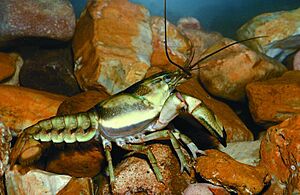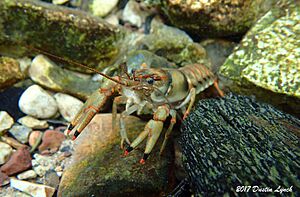Faxonius neglectus facts for kids
Quick facts for kids Faxonius neglectus |
|
|---|---|
 |
|
| Conservation status | |
| Scientific classification | |
| Genus: |
Faxonius
|
| Species: |
neglectus
|
| Subspecies | |
|
|
| Synonyms | |
|
Orconectes neglectus Faxon, 1885 |
|
The ringed crayfish (scientific name: Faxonius neglectus) is a type of freshwater crayfish. It lives naturally in Central North America. You can find it in two main areas: the Ozarks and around Nebraska.
Its scientific name, Faxonius neglectus, used to be Orconectes neglectus. In 2017, scientists decided that Faxonius should be its own group (genus). This happened because many crayfish once thought to be Orconectes were found not to live in caves, which is a key feature of true Orconectes species.
Contents
About the Ringed Crayfish
There are two types, or subspecies, of the ringed crayfish: F. neglectus chaenodactylus (also called the gapped ringed crayfish) and F. neglectus neglectus.
What They Look Like
The ringed crayfish has special markings on its body. It has a wide ring on its rostrum (a pointy part on its head). Its claws, called chelipeds, have a dark brown ring on the "finger" (dactyl) and the "palm" (propodus) parts. These rings end in bright red or orange colors. The third maxilliped (a mouthpart) looks scalloped. The main body shell, called the carapace, can be light brown or yellow. It often has a dark brown band just behind the head area.
It's hard to tell male and female ringed crayfish apart just by looking at them. They look very similar. Adult crayfish usually have a carapace (shell) length of about 32 millimeters.
How They Grow and Live
Like many other decapods (a group that includes crabs and shrimp), the ringed crayfish eats algae and detritus (dead plant and animal matter) in its watery home.
Young F. n. chaenodactylus crayfish shed their old shells (a process called molting) about 8 times in their first year. After that, they molt about 3 or 4 times each year.
Male ringed crayfish have special swimmerets (called pleopods) that curve towards their tail. Males can become adults in about 8 months. Their growth depends on how warm or cold the water is. Male F. n. chaenodactylus usually live for about 3 years, but some can live up to 5 years.
Female F. n. chaenodactylus also usually live for about 3 years, with some living up to 4 years.
Where They Live
The ringed crayfish lives in different places, both naturally and where it has been introduced.
Native Homes
The Faxonius neglectus has two separate groups of populations that live far apart from each other.
Faxonius neglectus neglectus
This subspecies lives in the Boston Mountains and Ozark Highlands in Arkansas, Kansas, Missouri, and Oklahoma. Another group lives in western and central Nebraska, and nearby parts of Colorado and Wyoming. There are also a few records of this crayfish in western Colorado, on the other side of the Continental Divide. This means they are in rivers that flow to the Pacific Ocean, not the Atlantic Ocean like other groups.
Scientists used to think some of these northern groups were just small, leftover populations. But now we know that F. n. neglectus is common in the western two-thirds of Nebraska. It also lives in nearby river systems like the Kansas River (especially the Republican and Big Blue branches), the Niobrara, and the Platte (including the Loup) rivers.
Faxonius neglectus chaenodactylus
This subspecies is only found in the rivers that flow into the White River in Arkansas and Missouri.
New Homes (Invasive Areas)
The ringed crayfish has also spread to new places where it doesn't naturally belong. It has been found in the Croton River (part of the Hudson River system) in New York, and in the Housatonic River in Connecticut. It is also an invasive species in the Spring River (Arkansas) in the Ozarks.
When F. neglectus moves into a new area, it can cause problems for the crayfish that already live there. For example, in some places where F. neglectus has settled, native crayfish like Orconectes eupunctus and Cambarus hubbsi have disappeared.




